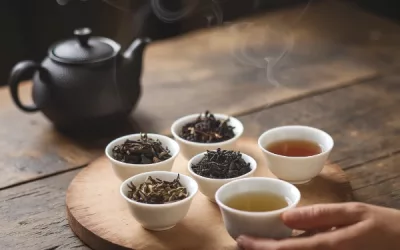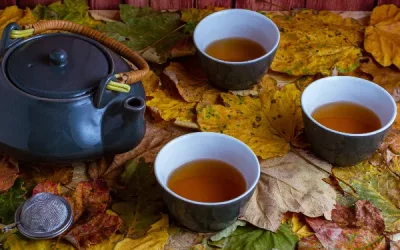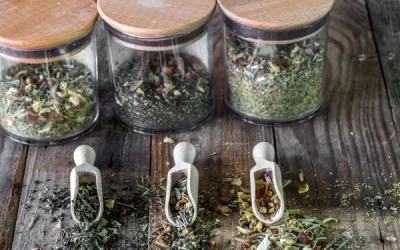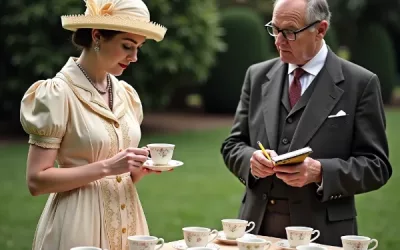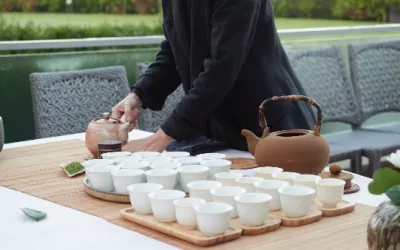Have you ever sipped a cup of tea and wondered why it didn’t taste quite right? For many, tea is more than just a beverage; it’s a ritual worth perfecting. In this ultimate guide, we’ll explore everything from essential ingredients to the art of steeping, ensuring that you, whether a novice or a seasoned enthusiast, can brew the perfect cup every time. Join me as we discover the nuances of tea-making and elevate your experience one sip at a time!
Table of Content
- What are the essential ingredients for making tea?
- How does water temperature influence tea brewing?
- What happens if water temperature is too high?
- What happens if water temperature is too low?
- What is the optimal steeping time for different teas?
- How can the tea-to-water ratio affect flavour?
- What types of tea are best for beginners?
- How can I customise my tea to suit my taste?
- What common mistakes should I avoid when making tea?
- How can I experiment with different tea types?
- Conclusion
What are the essential ingredients for making tea?
Making a great cup of tea starts with a few essential ingredients. Whether you’re a seasoned tea enthusiast or just beginning, understanding the fundamentals will elevate your tea experience. These essentials include high-quality tea leaves, good water quality, and optional additives like milk, sugar, or spices.
Using high-quality tea leaves is crucial. There are many types of tea leaves to choose from, each offering distinct flavours and aromas. The quality of water you use also plays a significant role in the final taste of your tea. Additionally, depending on personal preference, additives such as milk and sugar can enhance the overall experience.
What types of tea leaves are best for beginners?
When starting out, it’s essential to select tea leaves that are gentle on the taste buds and relatively easy to brew.
- Black Tea: Known for its robust and rich flavour, black tea is a popular choice for beginners. It’s forgiving when it comes to brewing time.
- Green Tea: Offers a fresh, slightly grassy flavour. It’s lighter than black tea and quite refreshing.
- Oolong Tea: Provides a complex mix of flavours ranging from floral to fruity. It’s a delightful choice for those ready to explore varied tastes.
- Herbal Tea: These are caffeine-free and come in various flavours like chamomile, mint, or hibiscus, making them perfect for those new to tea.
- White Tea: Offers a delicate and subtle flavour. It’s lightly processed and has a gentle taste.
Starting with these tea types will give you a good foundation and help you understand your preferences in flavour and strength.
How does water quality affect tea flavour?
Water quality can make or break your tea experience. Think of water as the canvas upon which your tea flavours are painted.
- Filtered Water: Using filtered water removes impurities and chemicals that can alter the taste.
- Fresh Water: Always use freshly drawn water. Water that has been sitting can develop a flat or stale taste.
- Water Temperature: Different teas require different temperatures. For instance, green tea needs lower temperatures (around 70-80°C), while black tea requires boiling water (100°C).
- Mineral Content: High mineral content (hard water) can affect the taste. Soft water is often recommended for brewing tea.
Ensuring your water maintains these qualities will highlight the true essence of your tea leaves.
What are the best additives for enhancing tea?
Adding extras to your tea can customise and elevate your drinking experience.
- Milk Varieties: Dairy milk can add a creamy texture. Non-dairy alternatives like almond milk, soy milk, or oat milk offer different flavour profiles.
- Sweeteners: White sugar, brown sugar, honey, or even agave syrup can sweeten the tea. Each offers a unique taste.
- Spices: Adding spices like cinnamon, cardamom, or cloves can transform your tea into a warming and aromatic drink.
- Lemon: A slice of lemon can add a tangy kick, especially to black or green tea.
- Mint Leaves: Fresh mint leaves add a refreshing hint to herbal or green tea.
Experimenting with these additives can lead to discovering your perfect cup of tea.
In the 1700s, tea became a significant beverage in Britain. One interesting tale involves Anna, the Duchess of Bedford, who popularised afternoon tea. She would invite friends over for tea and cake in the late afternoon to ward off hunger pangs before the evening meal. This practice quickly caught on, and afternoon tea became a beloved tradition in British society. It’s fascinating how a simple beverage can create cultural customs that last for centuries.
On a personal note, I remember my first journey into tea-making. I started with black tea, intrigued by its rich, robust flavour. Initially, I over-brewed it, causing a bitter taste. But with time and practice, I learned to appreciate the subtle nuances of different tea leaves and how to use filtered water to bring out the best flavours.
Experimenting with various additives, like a splash of almond milk or a hint of honey, transformed my morning routine. Now, a perfect cup of tea feels less like a daily habit and more like a cherished ritual.
How does water temperature influence tea brewing?
Water temperature plays a crucial role in tea brewing. It helps to extract the flavours, aromas, and beneficial compounds from the tea leaves. Different types of tea require different water temperatures to bring out their best characteristics.
The table below illustrates the ideal water temperatures for various types of tea and their recommended steeping times. Use the table to ensure that you brew each type of tea perfectly, maintaining its unique flavour profile and beneficial properties.
Ideal Water Temperatures for Different Types of Tea
| Tea Type | Ideal Temperature | Steeping Time |
|---|---|---|
| Green Tea | 70-80°C | 2-3 minutes |
| White Tea | 75-85°C | 4-5 minutes |
| Oolong Tea | 85-90°C | 3-5 minutes |
| Black Tea | 95-100°C | 3-4 minutes |
| Herbal Tea | 95-100°C | 5-7 minutes |
| Pu-erh Tea | 95-100°C | 4-5 minutes |
| Yellow Tea | 75-80°C | 3-4 minutes |
To use the table, first identify the type of tea you want to brew. Check the corresponding ideal temperature and steeping time. Heating your water to the right temperature and steeping for the recommended duration ensure that you extract the tea’s optimum flavours and benefits.
What happens if water temperature is too high?
If the water temperature is too high for the type of tea you’re brewing, you might find that the flavour becomes overly bitter or astringent. This can make your tea less enjoyable and can affect its overall quality.
- Green Tea: Becomes bitter and loses its delicate taste.
- White Tea: Loses its subtle floral notes and can taste flat.
- Oolong Tea: Develops a sharp, unpleasant astringency.
- Black Tea: Can become overly tannic and harsh.
- Herbal Tea: Might scorch the herbs, leading to a burnt flavour.
- Pu-erh Tea: Loses its complex earthy flavours and may taste muddy.
- Yellow Tea: Becomes astringent and loses its mellow aroma.
Following the recommended temperatures is essential for preserving the unique qualities of each tea type. It ensures that you’re getting the most out of your tea leaves.
What happens if water temperature is too low?
Conversely, if the water temperature is too low, the tea leaves may not release their full flavour or beneficial compounds. This can result in a weak, underwhelming cup of tea.
- Green Tea: May taste bland and watery.
- White Tea: Can be flavourless and lack complexity.
- Oolong Tea: Might not develop its rich, full-bodied character.
- Black Tea: Comes out weak and lacks depth.
- Herbal Tea: May not fully extract the herbs’ essence.
- Pu-erh Tea: Can be thin and underdeveloped.
- Yellow Tea: Lacks its characteristic richness and body.
Ensuring the right water temperature is crucial. It helps you get the best possible tea experience, each type offering its unique profile.
In the 19th century, the British Crown faced a tea deficit which prompted them to expand tea cultivation in India. Robert Fortune, a botanist, was sent to China to smuggle tea plants with the help of the East India Company.
This led to the birth of Assam and Darjeeling teas, which have since become world-renowned. The historical quest for the perfect tea has shaped current tea preferences and practices, including the importance of water temperature.
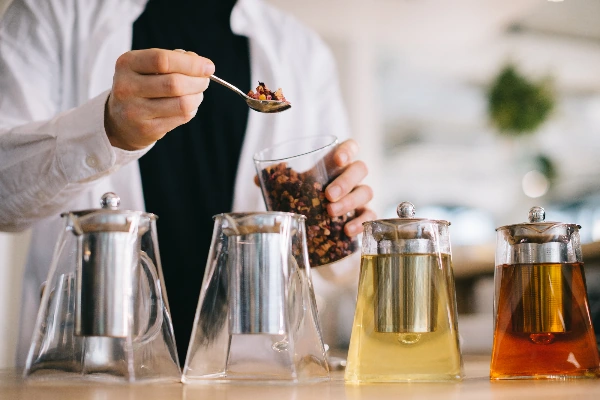
What is the optimal steeping time for different teas?
Here’s the deal: If you want to brew a perfect cup of tea, steeping time is the not-so-secret sauce to achieving that heavenly drink. Steeping time dictates flavour, strength, and all-around tea goodness. Pretend it’s like grilling a steak; get the timing wrong, and you might as well be chewing on leather. Likewise, you can end up with a bitter, sour or even bland cup if you mess up the steeping time for your tea. Now, let’s dive into the nitty-gritty of how to steep different types of tea.
Steeping times vary, essentially because different teas have different “personalities”. From the delicate green tea to the robust black tea, each requires a specific steeping duration to bring out its best qualities. Understanding the right steeping time for each is essential for achieving your desired flavour and strength.
How does steeping time affect tea bitterness?
Steeping time isn’t just a number; it can make or break your tea.
- Green Tea: Steeping too long can turn this delicate tea into a bitter mess. About 2-3 minutes at 70-80°C is all it needs.
- Black Tea: This hearty tea can handle 3-5 minutes steeping at boiling point (100°C). Any longer, and you’re sipping bitterness.
- Herbal Tea: These teas are more forgiving. Steep them for 5-7 minutes at 100°C, and you’re golden.
- White Tea: This fragile tea needs a gentle touch. 2-3 minutes at 70-80°C should do it.
- Oolong Tea: Oolongs are tricky. 3-5 minutes steeped in water at 80-90°C generally yields the best results.
So, tea gets cranky and bitter if you overdo it. Keep an eye on the clock for the best taste experience.
Can steeping time be adjusted for personal preference?
Absolutely! Steeping times are more flexible than you’d think.
- Shorter Steeping Time: If you prefer mild flavours and softer aromas, shortening the steeping time by a minute or so can achieve that.
- Longer Steeping Time: If you like your tea robust and strong, and don’t mind a bit of bitterness, extending the steeping time can make that happen.
- Temperature Tweaks: Different water temperatures can also influence the final taste, allowing for a more personalised cup.
- Multiple Infusions: Some teas, especially Oolong and Green, can be steeped multiple times, adjusting the time for each subsequent steep.
If you accept my two cents, first nail down the recommended times and then start experimenting. Trust me, it’s a fun ride.
Back in the day, around 2737 BC to be precise, Emperor Shen Nong of China discovered tea entirely by accident. Legend has it he was boiling water when leaves from a nearby tree blew into the pot. Ever the curious mind, he went ahead and drank the concoction, giving birth to tea as we know it. Imagine if he had let those leaves soak forever—our beloved tea could have ended up as history’s worst beverage.
How can the tea-to-water ratio affect flavour?
The tea-to-water ratio isn’t just a nerdy detail that tea aficionados obsess over. It’s the secret ingredient to crafting a cuppa that hits all the right notes. You see, much like the balance of cheese to crackers or the perfect amount of salt on your chips, the ratio of tea to water can make or break your brew’s flavour. Whether you’re aiming for a robust and punchy finish or a gentle and mellow sip, nailing this ratio is key.
But let’s be honest, nobody wants to drink something that tastes like the swampy dregs of a plant pot or, conversely, like flavoured water masquerading as tea. The ratio you choose directly influences the strength, aroma, and overall enjoyment of your tea. Different types of tea have their own sweet spots, and it all depends on your personal preference. In short, getting this ratio right is the golden ticket to tea nirvana.
What is the standard tea-to-water ratio?
For those of you who prefer clear, unambiguous instructions over vague poetic musings, the standard tea-to-water ratio is:
- For loose leaf tea: Use 1 teaspoon of tea leaves for every 8 ounces (about 240 millilitres) of water.
- For tea bags: One tea bag per 8 ounces (about 240 millilitres) of water.
Easy enough, right? Of course, this isn’t set in stone. Adjusting the ratio allows you to explore a whole spectrum of flavour profiles, making each brew an adventure.
Here’s a table showing the standard tea-to-water ratio for different types of tea:
| Type of Tea | Tea Quantity (per 8 oz/240 ml of Water) | Steeping Time | Water Temperature |
|---|---|---|---|
| Black Tea | 1 teaspoon (2.5 grams) | 3-5 minutes | 200-212°F (93-100°C) |
| Green Tea | 1 teaspoon (2.5 grams) | 2-3 minutes | 160-180°F (71-82°C) |
| Oolong Tea | 1 teaspoon (2.5 grams) | 3-5 minutes | 185-205°F (85-96°C) |
| White Tea | 2 teaspoons (5 grams) | 4-5 minutes | 160-185°F (71-85°C) |
| Herbal Tea | 1 tablespoon (6-8 grams) | 5-7 minutes | 200-212°F (93-100°C) |
| Pu-erh Tea | 1 teaspoon (2.5 grams) | 3-4 minutes | 200-212°F (93-100°C) |
| Matcha Tea | 1-2 teaspoons (2-4 grams) | Whisk until frothy | 160-175°F (71-80°C) |
Notes:
- Tea quantity can be adjusted according to personal preference for a stronger or milder brew.
- Steeping time can also be adjusted based on taste; longer steeping results in a stronger flavor.
- Water temperature is crucial, especially for delicate teas like green and white tea, to avoid bitterness.
This table provides a general guide for making the perfect cup of tea with the right tea-to-water ratio.
How can I adjust the ratio for stronger tea?
Sometimes, life demands a stronger brew. Whether you’ve had a late night or you’re just in the mood for a more intense hit, tweaking the ratio can amp up the strength.
- Use more tea leaves or an extra tea bag while keeping the water amount the same.
- Double the amount of tea but only increase the water slightly (like from 8 ounces to 10 ounces).
- Steep the tea for a longer period, though be wary of venturing into bitter territory.
With these adjustments, you’ll be sipping on a cup that can stand up to your toughest mornings.
What mistakes should I avoid in measuring?
Measuring tea might sound like a walk in the park, but even seasoned tea drinkers can stumble into some common pitfalls. Here’s what to watch out for:
- Overloading the tea leaves: Avoid cramming too many leaves into your infuser. You’re making tea, not salad.
- Inaccurately measuring water: Eyeballing the amount of water can throw off the balance. Use a measuring cup, not your “gut feeling.”
- Ignoring the type of tea: Different teas have different sizes and densities. A teaspoon of fluffy white tea leaves isn’t the same as a teaspoon of dense black tea.
- Using hard water: Minerals in hard water can mess with the flavour balance. Filtered water is your friend.
- Steeping too long or too short: Each type of tea has its own ideal steeping time. Follow the guidelines or risk making your tea taste like a science project gone wrong.
Avoid these missteps, and you’ll be well on your way to tea perfection.
Here’s a fun nugget of history for you: In the 18th century, tea was so treasured in Britain that people would lock up their tea leaves in ornate boxes with keys, known as tea caddies. One clever lady, Lady Mary Coke, even passed off boiled water as tea when her supplies ran low. Rumour has it, nobody noticed. Maybe they didn’t get the memo about the tea-to-water ratio back then!
What types of tea are best for beginners?
So, you’re dipping your toes into the vast ocean of tea? Fantastic choice! It’s a world brimming with flavours, aromas, and health benefits. But let’s not get ahead of ourselves. Let’s break it down and simplify things for you. No one wants to start with the tea equivalent of rocket science. Here’s a rundown of the most beginner-friendly teas and why they deserve a spot in your tea cupboard.
To begin with, if you want something classic and reliable, black tea is your go-to. It’s like the plain cheese pizza of teas. Safe, standard, and hard to mess up. Next up, green tea offers a fresh, grassy taste and a bundle of health benefits. Then there’s herbal tea, which is caffeine-free and often loaded with calming properties – perfect for unwinding. Chai, a spiced wonder, brings warmth and comfort, especially on chilly days. Finally, rooibos, the South African red bush, is another caffeine-free option with a naturally sweet and nutty flavour.
Which tea is the easiest to brew?
For a brew that’s as easy as boiling water (literally), black tea is your friend. This tea doesn’t require much finesse – just hot water and patience.
- Black tea: Highly forgiving, withstands high temperatures without losing its mojo.
- Rooibos: Also quite forgiving; doesn’t get bitter even if you leave it brewing while you answer that oh-so-important phone call.
- Herbal tea: Similarly forgiving and doesn’t require specific water temperatures.
Black tea’s robustness also means you can experiment with adding milk or sugar without ruining your cuppa. It’s practically foolproof!
What flavours should beginners look for?
When you’re at the start of your tea journey, some flavours can help you ease into this lovely ritual. Choose flavours that are naturally appealing and not too overwhelming.
- Citrus: Bright and zesty, easy on the palate, like a gentle morning wake-up.
- Mint: Fresh, cooling, and absolutely invigorating.
- Chamomile: A gentle, soothing floral flavour perfect for winding down.
- Berries: Sweet and tart, a pleasing combo that’s hard to get wrong.
- Vanilla: Smooth, creamy, and a universal favourite.
These flavours aren’t too bold or polarizing, making them a great starting point for tea newbies. They give you an excellent baseline from which to explore more complex flavours as your taste buds become more educated.
Are there any specific brands recommended for beginners?
Sure, you wouldn’t want to jump in blind and end up with something dreadful. Here are some brands that are consistent and beginner-friendly.
- Twinings: Known for a wide range of flavours and solid quality.
- Tazo: Offers robust, flavourful options that are not too pricey.
- Bigelow: A staple in many households; offers trustworthy flavours.
- Celestial Seasonings: Great for herbal varieties and unique flavour blends.
- Harney & Sons: A bit more premium, but a reliable brand with quality offerings.
These brands are easy to find in most supermarkets or online, ensuring you’re not left hunting in some dingy back alley for your next tea fix.
Now, for a bit of human history to sprinkle on your newfound tea knowledge. Did you know that tea bags – those convenient little pouches – were an accidental invention? Around 1908, Thomas Sullivan, a New York tea merchant, sent out samples of tea in small silk bags. Unintentionally, his customers mistook these as single-use infusers and plopped the entire bag into hot water.
Much to Sullivan’s surprise (and delight), this mistake quickly caught on, and the tea bag industry was born. Imagine, an entire way of brewing tea started as a happy accident. Just like how your tea journey might begin – perhaps not perfect, but full of potential and delightful surprises. Cheers!
How can I customise my tea to suit my taste?
So, you’re looking to turn that boring cup of tea into something more exciting and fit for royalty, huh? Alright, grab your favourite mug and let’s dive in. Customising tea is like being an artist with a blank canvas. You have endless ways to alter and enhance your tea until it hits that perfect spot on your taste buds. From adding milky textures to sweet sprinkles, infusions of vibrant flavours, creative serving ideas, and delightful garnishes—there’s something for everyone.
Imagine you’re setting up for a tea party. You got your kettle boiling, and now it’s time to get creative. But first, let’s address the basics.
What are popular flavour infusions for tea?
You might think flavour infusions are reserved for culinary geniuses, but it’s much simpler than that. By adding a touch of this or a hint of that, you can elevate your tea game.
- Fruit Infusions: Lemons and limes aren’t just for cocktails. Add a slice and let it sit for a citrus punch.
- Herbal Enhancements: Mint leaves, ginger slices, and lavender can transform your tea into something fresh and soothing.
- Spicy Twists: Cinnamon sticks, star anise, and cloves are great for a warm, spiced kick.
- Floral Additions: Rose petals, chamomile blossoms, and hibiscus can add both aroma and subtle flavours.
- Berry Bursts: Blueberries, raspberries, and strawberries infuse well for a naturally sweet and colourful touch.
Spicing up (literally and metaphorically) your tea isn’t challenging. Get a bit of this and a bit of that. Chuck it in and let your tea steep to soak in all those wonderful flavours. The right blend of infusions can make your tea both an aromatic and flavour explosion.
How do I know how much milk to add?
The age-old debate: to milk or not to milk. Now, assuming you do want to add milk to your tea, the amount can make all the difference between a delightful cuppa and a watery mess.
- Tasting First: Before adding milk, take a sip. The strength of your tea will dictate the milk quantity.
- Initial Ratio: Start with a small splash. About a tablespoon for a regular cup of tea.
- Gradual Additions: Add more milk little by little until the colour and taste feel just right.
- Different Types: Experiment with kinds of milk – whole, skimmed, oat, almond – as each one brings in a unique flavour.
- Temperature Test: Make sure the milk isn’t too cold, as it can cool down your tea quickly. Warm it slightly if necessary.
In tea terms, it’s like Goldilocks finding the porridge that’s just perfect. Whether you like it creamy or with just a hint of milkiness, there’s no one-size-fits-all answer. Tailor it as per your preference.
What are some creative serving ideas?
Alright, so you’ve made your perfect brew—now let’s talk presentation. Because we all know, Instagramming your tea is half the fun.
- Glass Teapots: Watching the tea steep is like free entertainment.
- Mason Jars and Tumblers: Perfect for iced teas or a rustic look.
- Floral Tea Sets: Best for a vintage feel or a fancy afternoon tea.
- Tea Towers: Stack your snacks on a multi-tiered stand. Fancy pastries, anyone?
- Seasonal Themes: Pumpkin mugs for autumn, floral cups for spring—get festive.
- Garnishes: Fresh mint leaves, edible flowers, or a cinnamon stick perched on the edge of the cup.
Serving your tea creatively can elevate the entire tea-drinking experience. It’s like adding icing to a cake—optional, but oh-so-satisfying.
Speaking of satisfaction, did you know that tea customisation isn’t exactly a modern-day phenomenon? Back in the 18th century, Anna, the Duchess of Bedford, was so fed up with the ‘sinking feeling’ she got in the late afternoons that she started having tea with little snacks to tide her over until dinner. This practice evolved into the beloved British tradition of afternoon tea! So, the next time you feel peckish around 4 PM, remember Anna, and maybe throw in some scones and jam with your tailor-made tea. Cheers!
What common mistakes should I avoid when making tea?
Alright, imagine this: You’re craving the perfect cuppa, but instead, you end up with a cup of sadness. It happens to the best of us. Making tea isn’t rocket science, but it can go awry if you’re not careful. Let’s dive into some common pitfalls and how to avoid them, so you can make a brew your nan would be proud of.
First off, the heavy hitters. Using boiling water is a no-no for certain teas. Next, timing is everything; let it steep too long or too short, and you’re in for a disappointment. Then, there’s the quality of the leaves – if you’re using the dusty bits at the bottom of the box, don’t expect a divine experience. Ratios matter too – too much or too little tea can ruin the balance. And cleanliness? Oh boy, a dirty teapot is a crime against humanity.
What happens if I use boiling water for green tea?
Green tea, ah, the delicate darling of the tea world. Pouring boiling water over it is akin to flambeing a delicate soufflé – it just doesn’t end well.
- Green tea leaves are sensitive. Boiling water scorches them, leading to a bitter and harsh taste.
- Aim for water that’s about 70-80°C (160-175°F). This helps to preserve the delicate flavours and antioxidants that make green tea delightful.
- Use a thermometer if you must, but in a pinch, let your boiled water cool for a minute or two before pouring it over the leaves.
- The goal is to extract the zelené freshness and lovely nuances, not turn it into a cup full of regret.
Overdoing the temperature ruins the magic. Green tea should taste refreshing, not like a mouthful of bitter disappointment. Aim for the right temp, and your taste buds will thank you.
How can I ensure my tea remains fresh?
Stale tea is a tragedy of Shakespearean proportions. If your cupboard is a time capsule of forgotten teas, let’s fix that.
- Store tea in an airtight container to prevent exposure to air and moisture.
- Keep it in a cool, dark place, away from direct sunlight. Think of it like a vampire – darkness is its friend.
- Avoid strong odours. Tea leaves are like sponges; they absorb surrounding scents, and no one wants chai that smells like last night’s curry.
- Buy smaller quantities if you’re not a regular tea drinker. Freshness is key; the smaller the stash, the quicker you’ll go through it.
- Label your containers with dates to keep track of how long you’ve had the tea. If it’s older than your last relationship, it might be time to toss it.
Following these guidelines ensures you avoid the heartache of musty, stale tea. Fresh tea is like a faithful companion – it rewards you with each brew.
What are the signs of over-steeping?
Ah, over-steeping – the villain of the tea world. It’s that moment when you realize you’ve let your tea sit too long and it’s gone from delightful to disastrous.
- Astringency kicks in hard. Instead of a pleasant sip, you’re greeted by a mouth-puckering bitterness.
- The colour of your brew can be a dead giveaway. Too dark, and you might’ve crossed into bitter territory.
- Astringent aftertaste. If it feels like your tongue is trying to run away from your mouth, you’ve overdone it.
- Loss of flavour complexity. Over-steeping dulls the nuanced flavours that make tea enjoyable.
- General unpleasantness. If you’re wincing with each sip, you’ve overstepped the mark.
Finding that sweet spot means keeping an eye on steeping times. Use a timer, pay attention, and you’ll enjoy a beautifully balanced tea experience.
Legend has it that the Japanese tea ceremony, called Chanoyu, is all about precision and balance. Back in the 16th century, tea master Sen no Rikyū set the gold standard for how tea should be treated.
His meticulous approach ensured that every step, from water temperature to steeping time, was executed with elegance and purpose. Think of yourself as a modern-day Rikyū, and treat your tea-making with the same reverence. You might not reach zen, but at least you’ll get a fantastic cup of tea.
How can I experiment with different tea types?
So, you want to dip your toes into the vast ocean of tea? Excellent choice! Experimenting with different tea types and brewing methods can open your taste buds to a world of flavours and aromas you never knew existed. You’ll never look at a teabag the same way again.
First of all, trying new flavours can be an adventure. It’s like going on a flavour safari without leaving your kitchen. Whether it’s the floral notes of jasmine tea or the smoky undertones of Lapsang Souchong, every type of tea brings something unique to the table. Blending teas is another fun way to shake things up. You become an alchemist, creating your own concoctions and seeing what delightful or disastrous mixes you can come up with.
Exploring international varieties is akin to taking a round-the-world trip. Each country has its own tea-drinking culture and distinctive brews. Not to mention using different brewing tools. You can go all traditional with a teapot, or get fancy with a gaiwan or a French press. Finally, tracking your preferences can be as satisfying as ticking off countries in your travel diary. Keeping notes helps you remember what you liked and what tasted more like a soggy carpet.
How do I start blending my own teas?
Blending your own teas is like playing mixologist, but for tea instead of cocktails. You don’t need a PhD in Herbology; just a bit of curiosity and a decent sense of taste will do.
- Pick Your Base: Start with a straightforward base like black, green, or white tea. These teas provide a sturdy foundation for your blend.
- Add Flavours: Think about complementary flavours. Herbs like mint, spices like cinnamon, fruits like dried berries, and even flowers like rose petals can elevate your blend.
- Experiment in Small Batches: Don’t go all mad scientist on day one. Start with small amounts to see how the flavours interact.
- Balanced Ratios: Typically, you want about 80% base tea and 20% added ingredients. But who am I to stifle your creativity? Adjust to your liking.
- Taste Test: The proof is in the proverbial pudding—or in this case, the teacup. Brew a small cup and see how it turns out.
Once you get the hang of it, you’ll find yourself blending like a pro. Just remember to write down your favourites so you can recreate them later without racking your brain.
What international teas should I try?
If you’re game for a global taste tour, international teas offer diverse flavour profiles that can knock your socks off.
- Matcha (Japan): Vibrant, powdered green tea that’s famous for its umami-rich flavour and caffeine kick.
- Masala Chai (India): An aromatic blend usually featuring black tea, cardamom, cinnamon, ginger, and other spices.
- Earl Grey (UK): Black tea with a twist of bergamot, providing a fragrant and slightly citrusy experience.
- Oolong (China): Semi-oxidised tea that can range from floral to fruity in flavour. It’s the chameleon of teas.
- Rooibos (South Africa): Naturally caffeine-free with a sweet, nutty flavour, making it perfect for bedtime.
Trying these international teas can not only broaden your palate but also give you a tiny glimpse into other cultures.
How can I keep track of my tea experiences?
Keeping track of your tea adventures ensures you don’t repeat the same mistakes—like over-steeping that delicate white tea until it tastes like dishwater.
- Tea Journal: Record the name of the tea, where you got it, and your tasting notes. Jot down the brewing method and any thoughts on improvement.
- Rating System: Create your own system—thumbs up, stars, smiley faces, whatever works for you—to quickly rate your teas.
- Digital Apps: There are tea apps where you can log your experiences, take photos, and share your reviews with other tea enthusiasts.
- Tea Box Labels: If you’re a bit lazy with the journals, just keep the labels and jot down your notes directly on the packaging.
- Social Media: Sharing your tea journey on platforms like Instagram can be fun. Plus, you get the added benefit of community feedback and recommendations.
Tracking your tea preferences will make you a more discerning tea connoisseur in no time, and it’s a great conversation starter at parties.
Let’s wrap this up with a delightful tale from history. During World War II, Britain faced a tea shortage (gasp!). To tackle this crisis, Lord Woolton, the Minister of Food, launched an initiative for people to blend their own teas from local herbs.
The “National Tea Blending Booklet” guided Brits on how to use substitutes like rosehip, blackberry leaves, and even dandelions. So, if you’re worried about making a terrible blend, just remember: whatever you concoct probably won’t be as weird as some wartime brews!
Conclusion
As I reflect on the journey to mastering the art of tea-making, I recognise the intricate nuances that transform a simple brew into a delightful experience. From understanding the essential ingredients, such as high-quality tea leaves and filtered water, to the delicate balance of steeping times and tea-to-water ratios, each element plays a pivotal role in crafting the perfect cup. The importance of water temperature cannot be overstated; it varies with each tea type and directly influences flavour, making a well-informed choice crucial.
Moreover, the ability to customise tea to suit our individual tastes and preferences opens new avenues for creativity. With the right additives, such as milk or spices, and an adventurous spirit to experiment with blends and international varieties, the world of tea becomes a personal canvas. Through my own exploration, I’ve discovered that even small adjustments can yield significantly different results, leading to a remarkably personalised tea ritual.
As we continue to navigate our tea-making adventures, I encourage each of you to embrace experimentation and learn from common pitfalls. Avoiding mistakes like using boiling water for green tea or neglecting proper measurements can elevate our brews astonishingly. Perhaps consider keeping a journal to track your tea experiences; it not only helps in perfecting your approach but also turns into a cherished collection of flavours and memories.
In the end, tea is not merely a beverage; it’s a bridge to myriad experiences, cultures, and moments of tranquillity. So, the next time you brew a cup, think about what it represents and the journey it takes to reach your hands. What stories will you share with each sip?
Resources
- The Influence of Water Composition on Flavor and Nutrient Extraction in Tea
- The types of brewing water affect tea infusion flavor by changing the tea mineral dissolution
- Influence of steeping conditions (time, temperature, and particle size) on antioxidant activity and sensory attributes of tea
- Enhancing the flavor profile of strong-flavored green tea from Sichuan
- Green Tea (Camellia sinensis): A Review of Its Phytochemistry, Pharmacology, and Toxicology
- Steeping temperature and time may affect antioxidants in tea


